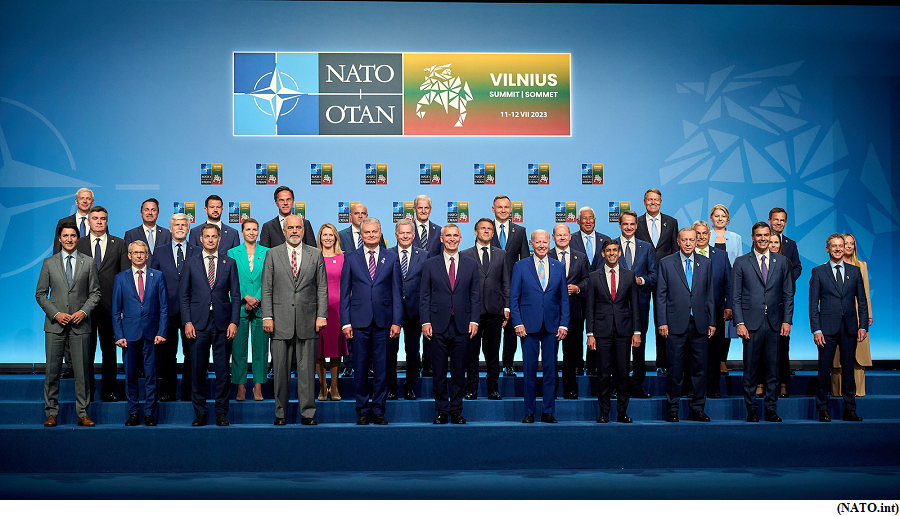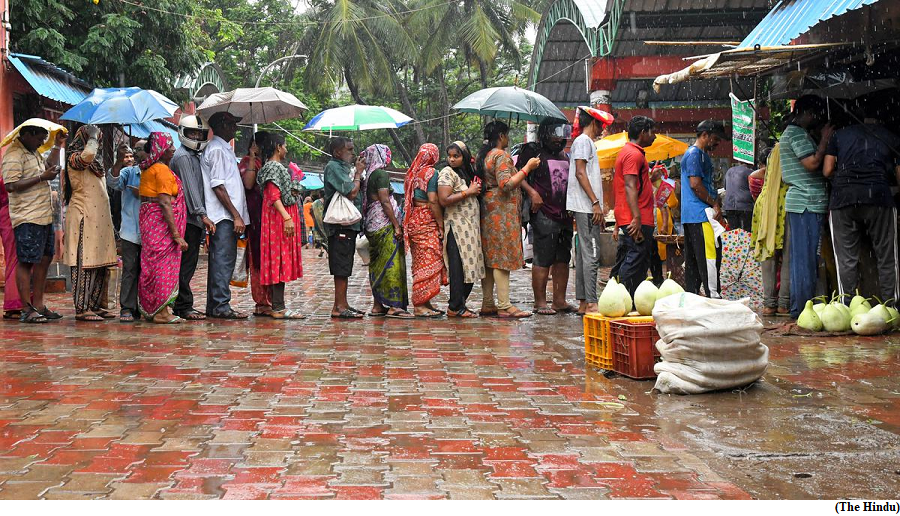NATO’s Vilnius Summit (GS Paper 2, International Organisation)

Why in news?
- Recently, the 2023 NATO Summit took place in Vilnius, the capital of Lithuania.
How was this summit different?
- A standout of the Vilnius Summit was the attendance of Ukrainian President Volodymyr Zelenskyy and the anticipation around the possibility of extending NATO membership to Ukraine.
- In this regard, the launch of the NATO-Ukraine Council as a forum for crisis consultations and decision-making indicated that NATO tried to assuage the feelings of Ukraine for not being included in the alliance by creating a mechanism for its wider engagement, support and future inclusion as a full member.
- All three priorities outlined by Ukraine; new weapons packages, security guarantees and an invitation to join NATO went unfulfilled. However, the U.K. did pledge ammunition support to Ukraine.
- Additionally, garbed in the urgency to help Ukraine, NATO has levelled up its own defences.
- NATO’s new plans involve maintaining a force of 300,000 troops, with air and naval capabilities, while emphasising the importance of a strong industrial base, leading to the endorsement of a Defence Production Action Plan.
What is the significance of the entry of new members?
- The inclusion of Finland and approval of Sweden as NATO members indicates a few things.
- It signals that the Alliance continues to practise Article 10 of the Washington Treaty signed in April 1949 which states that member countries can invite other European countries to become members of NATO. It rests Ukraine’s potential membership on fertile grounds and conceptually deters Russia from taking steps against members of NATO.
- Turkey’s scaling back of its long-standing opposition to Sweden’s inclusion in NATO is a significant shift.
Who are other threat actors to NATO?
- The Vilnius summit minced no words on the challenges and threats emerging from China’s stated ambitions and coercive policies.
- It stated that NATO faces threats from China’s malicious hybrid cyber operations, as well as confrontational rhetoric and disinformation, which specifically aim at NATO allies and pose a threat to the security of the Alliance.
- The NATO summit emphasised that the developments in the Indo-Pacific have become increasingly consequential for Euro-Atlantic security with expanding space for Quad countries, along with other regional countries like New Zealand and South Korea.
- But even as the summit was on, Russia launched a drone attack on Kyiv, depicting an undeterred approach to NATO’s potential expansion. It is this contestation that is likely to define the future of Eurasian security.
Why are tomato prices still high?
(GS Paper 3, Economy)
Why in news?
- As prices of tomatoes hover between ₹100 and ₹200 in various parts of the country, the Reserve Bank of India’s latest monthly bulletin has highlighted that the volatility of tomato prices has historically contributed to overall inflation levels in the country.

How is tomato produced in India?
- Tomato production in the country is concentrated regionally in the States of Andhra Pradesh, Madhya Pradesh, Karnataka, Odisha, and Gujarat, which account for close to 50% of total production.
- There are two major crops of tomato annually; kharif and rabi. The rabi crop hits the market between March and August annually while the kharif crop comes to markets from September.
- Some regions in Maharashtra and Himachal Pradesh’s Solan are able to grow tomatoes during the monsoon months, while in the summer, Andhra Pradesh’s Madanapalle region alone accounts for tomato cultivation in the entire country.
- As for tomato production, it peaked in 2019-20 at 21.187 million tonnes (MT) and has been declining since. In 2021-22, it dropped to 20.69MT and 20.62MT in 2022-23.
What is fuelling the price rise?
- There are multiple factors for the dip in overall tomato production, with the two key reasons being extreme weather conditions and low commercial realisation of the crop for farmers in the months before June as well as last year.
- The heatwaves and high temperatures in April and May along with delayed monsoon showers in southern India and Maharashtra led to pest attacks in tomato crops.
- A lot of farmers resorted to selling whatever crop they had at these prices while some abandoned their crops. This led to a crunch in supply. Later, incessant rains in tomato-growing regions further affected the new crop.
- The fact that July-August is a lean production period for tomato, as it falls between yields, compounded the problem.
- Reports show that many farmers in the Kolar district of Karnataka, which is usually responsible for sizeable tomato supplies, shifted to beans owing to the higher prices it fetched last year.
How can volatility be controlled?
- Policy experts say high volatility can be tamed by making some improvements.
- Since tomato is highly perishable, improved value and supply chains can help with the problem. An organised value chain involves a market-focussed collaboration of a set of entities working in tandem to produce, process and market products and services in an effective and efficient manner.
- An ICRIER study suggests increasing the processing capacity for tomatoes. Building more processing units and linking tomato value chains to processing of at least 10% of tomato production into tomato paste and puree during peak seasons, and using them in the lean season when fresh tomato prices spike can be a solution.
- The development of integrated cold chains has also been suggested.
Rajasthan minimum income Bill, provisions, what makes it unique
(GS Paper 2, Governance)
Why in news?
- Recently, the Rajasthan State government tabled the Rajasthan Minimum Guaranteed Income Bill, 2023, which effectively seeks to cover the entire adult population of the state with guaranteed wages or pension.

What is the Bill?
- Under the Bill, all families of the state get guaranteed employment of 125 days every year, while the aged, disabled, widows, and single women get a minimum pension of Rs 1,000 per month. Importantly, the pension will be increased at the rate of 15 per cent each year.
- The Bill has three broad categories:
- right to minimum guaranteed income,
- right to guaranteed employment, and
- right to guaranteed social security pension.
- The government anticipates an additional expenditure of Rs 2,500 crore per year for this scheme, which may increase with time.
What are its major provisions?
Minimum guaranteed income:
- Each adult citizen of the state has been guaranteed a minimum income for 125 days a year through the Rajasthan government’s flagship Indira Gandhi Shahri Rozgar Guarantee Yojana for urban areas, and through Mahatma Gandhi National Rural Employment Guarantee Act (MGNREGA) in rural areas.
- In his budget speech 2023, Chief Minister had increased the employment guarantee per family from 100 days to 125 days for his urban employment scheme. The state will supplement the MGNREGA’s 100 days by providing jobs for an additional 25 days in rural areas.
- Next, the government will provide eligible categories with a minimum pension of Rs 1,000.
Guaranteed employment:
- The right to employment states that post the work in urban or rural employment schemes, the minimum wages should be paid “weekly or in any case not later than a fortnight.”
- The state will designate a program officer, not below the rank of Block Development Officer in rural areas and an Executive Officer of the local body in urban areas to implement the Act.
- Among other things, the Program Officer shall ensure that the work site is within a radius of five kilometres of where the job card is registered in both rural and urban areas.
- If the Program Officer fails to provide employment within 15 days from the receipt of the application, the applicant shall be entitled to an unemployment allowance on a weekly basis “and in any case not later than a fortnight.”
Guaranteed social security pension:
- Every person falling in the category of old age/specially abled/widow/single woman with prescribed eligibility shall be entitled to a pension.
- It will increase over the base rate in two instalments — 5 per cent in July and 10 per cent in January of each financial year 24 starting 2024-2025.
How have social activists reacted?
- Social activist said the Bill contains many firsts in the country.
- The Bill’s approach, guaranteeing minimum employment and pensions by law, distinguishes it from the cash transfer schemes that various other states have.




